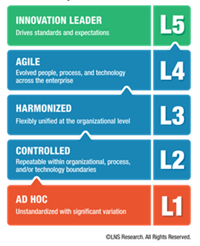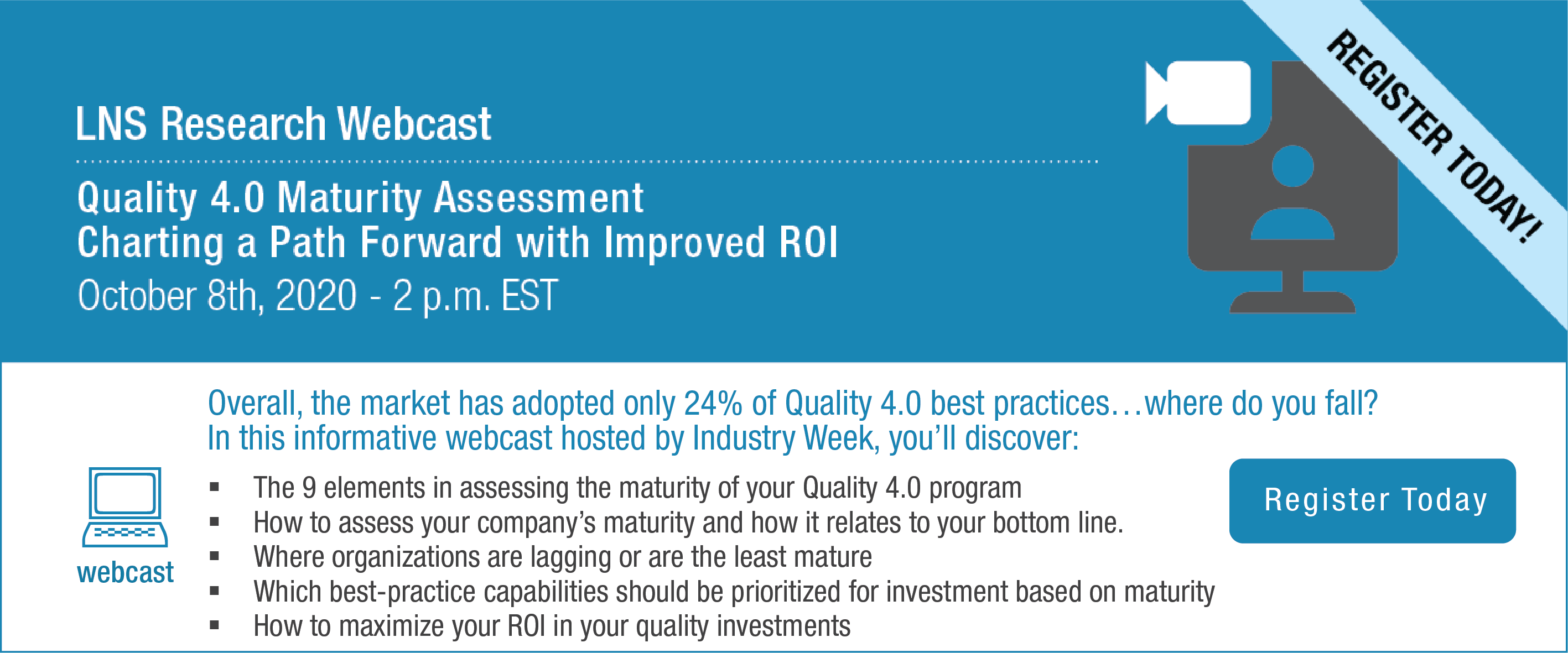With adoption rates of Industrial Transformation (IX) continuing to grow over the past five-plus years, we now have enough historical perspective to create a maturity model to assess organizational efforts in the pursuit of improved business performance. This is especially helpful within Quality 4.0.
 In a recent study on Quality 4.0, LNS Research has identified 107 best-practice capabilities across People, Process, and Technology – aligned to nine organizational elements (Leadership, Culture, Competency, Management systems, Agility, Risk, Connectivity, Applications, and Analytics), and benchmarked 250 industrial companies in these nine elements. These 107 capabilities and nine elements of maturity are explained in detail in our published Spotlight, “Quality 4.0 Maturity Assessment: Charting a Path Forward.”
In a recent study on Quality 4.0, LNS Research has identified 107 best-practice capabilities across People, Process, and Technology – aligned to nine organizational elements (Leadership, Culture, Competency, Management systems, Agility, Risk, Connectivity, Applications, and Analytics), and benchmarked 250 industrial companies in these nine elements. These 107 capabilities and nine elements of maturity are explained in detail in our published Spotlight, “Quality 4.0 Maturity Assessment: Charting a Path Forward.”
Of these 107 capabilities, it’s clear that the maturity level of an organization is directly proportional to the number of best practices adopted, regardless of which practices they are. This is because every company is unique; what works for one company might not work for another. So, while there is certainly no one-size-fits-all formula for a successful Quality 4.0 program, our report examines very clear lessons that stand out and are most-adopted for certain levels of maturity. Moreover, in the full report, we discuss those capabilities most likely to help a company move from one level to another.
As we dissect levels of maturity and what they mean for companies engaged in  Quality 4.0 initiatives, we discover that a comparison of the various levels brings about some interesting results. For example, our research shows that companies at levels two and three are highly similar in the number of best practices adopted, whereas level one companies have a wider distribution of best practices adopted. In addition, as companies attempt to move up through levels, it takes any single organization relatively more investment in best practice capabilities to get from level one to two, or four to five, than other levels.
Quality 4.0 initiatives, we discover that a comparison of the various levels brings about some interesting results. For example, our research shows that companies at levels two and three are highly similar in the number of best practices adopted, whereas level one companies have a wider distribution of best practices adopted. In addition, as companies attempt to move up through levels, it takes any single organization relatively more investment in best practice capabilities to get from level one to two, or four to five, than other levels.
Quality 4.0 programs are not just about manufacturing operations; they transcend several aspects of business. To be a true Innovation Leader, a company must be successful in several of these aspects. The LNS Research maturity model is not intended to simply give a maturity score, but to also give insights within nine distinct elements across People, Process, and Technology. In evaluating these nine elements, our research shows that the overall market has adopted 24% of best practices on average. As such, there is much room left for improvement.
Some of the highlights from this analysis are:
- Leadership is the lagging people sub-element, especially for higher levels of maturity.
- Technology is the least mature of the three categories.
- Connectivity is the least mature technology sub-element, followed by applications and leadership.
Armed with this information, the question becomes, given your organization’s current maturity level, which best-practice capabilities should you prioritize for investment? In our full report, LNS Research provides specific recommendations and guidance on how to answer this very important question. Our goal is to help you maximize your ROI as you work toward higher levels of quality maturity.
To learn more about LNS Research’s maturity model and further develop your Quality 4.0 program while maximizing ROI, download the full report today.
